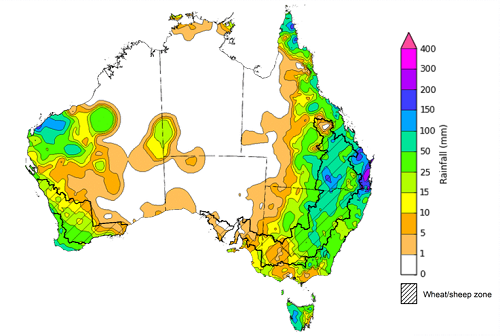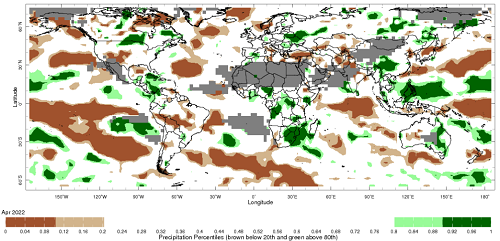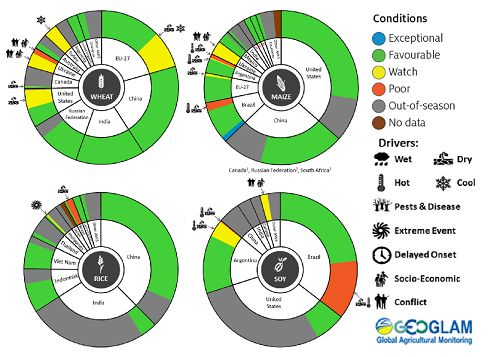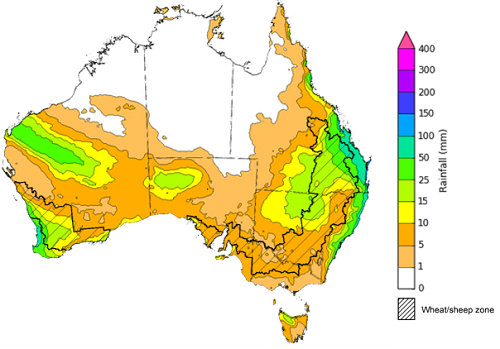Key issues
- For the week ending 18 May 2022, onshore winds and a low-pressure trough across eastern Australia resulted in substantial rainfall in the east of the country, with cold fronts resulting in moderate rainfall in the west and Tasmania. Meanwhile, high-pressure systems over central and southern Australia brought dry conditions to these areas.
- Wet conditions across New South Wales and Queensland likely brought field activity to a standstill. Prior to the heavy rainfalls, harvesting of summer crops was still ongoing across northern cropping regions of Australia, with sprouting of unharvested crops now very likely. Winter planting programs were also well underway. Upper layer soil moisture levels are well above average across eastern Australian cropping regions, which will support the germination and establishment of winter crops. However, the recent rainfall has also resulted in localised flooding, disrupting logistics and potentially requiring growers to replant winter crops in some cases.
- Below average rainfall globally during April is likely to result in lower-than-expected winter wheat production potential in the United States, India, Turkey and parts of Kazakhstan. Further, the conflict in Ukraine has generated additional levels of uncertainty around wheat production for 2022. Below average rainfall and above average temperatures in recent months has also negatively affected corn and soybean production across parts of Argentina and Brazil. Global production conditions have deteriorated compared to those used to formulate ABARES forecasts of global grain supplies and world prices in its March 2022 edition of the Agricultural Commodities Report. As a result, global grain and oilseed production is likely to be lower than that forecast in March.
- Over the 8-days to 26 May 2022, low-pressure troughs in eastern Australia are expected to bring moderate rainfall to the east of the country, with a cold-front bringing rainfall to parts of Western Australia. High-pressure systems in the south of the country will bring mostly dry conditions. Forecast wet conditions in northern New South Wales and Queensland will further delay harvesting of summer crops and the planting of winter crops. Planting activity across Victoria, South Australia and Western Australia is expected to continue over the coming week, as growers proceed with planting wheat and barley. Soil moisture levels are average to above average for this time of year, and the seasonal forecast expects a wetter than average winter across most cropping regions.
- Water storage in the Murray–Darling Basin (MDB) increased by 73 gigalitres (GL) between 11 May 2022 and 18 May 2022. The current volume of water held in storage is 21,627GL, which represents 86% of total capacity. This is 49% or 7,081 GL more than at the same time last year.
- Allocation prices in the Victorian Murray below the Barmah Choke decreased from $43 per ML on 6 May 2022 to $27 per ML on 13 May 2022. Prices are lower in the Goulburn-Broken, Murrumbidgee and regions above the Barmah choke due to the binding of the Goulburn intervalley trade limit, Murrumbidgee export limit and Barmah choke trade constraint.
Climate
For the week ending 18 May 2022, onshore winds and a low-pressure trough across eastern Australia resulted in substantial rainfall in the east of the country, with cold fronts resulting in moderate rainfall in the west and Tasmania. Meanwhile, high-pressure systems over central and southern Australia brought dry conditions to these areas.
Rainfall totals of between 10 and 100 millimetres were recorded across much of New South Wales, eastern Queensland, the far south-east of South Australia, the west and central east of Western Australia, as well as parts of Victoria, the Northern Territory and eastern Tasmania. Rainfall totals in excess of 100 millimetres were recorded across central and north-eastern New South Wales, south-eastern and northern Queensland, north-west Western Australia and parts of western Tasmania. Remaining parts of Australia received little to no rainfall.
In cropping regions, rainfall totals of between 10 and 100 millimetres were recorded across New South Wales, much of Queensland and Western Australia, as well as isolated parts of Victoria and South Australia. Rainfall in excess of 100 millimetres was recorded in cropping regions in parts of southern Queensland. Little to no rainfall was recorded across cropping regions in remaining parts of Victoria and South Australia.
Wet conditions across New South Wales and Queensland likely brought all field activity to a standstill. Prior to the heavy rainfalls, harvesting of summer crops was still ongoing across northern cropping regions of Australia, with sprouting of unharvested crops now very likely. Winter planting programs were also well underway. Upper layer soil moisture levels are well above average across east Australian cropping regions, which will support the germination and establishment of winter crops. However, the recent rainfall has also resulted in localised flooding, disrupting logistics and potentially requiring growers to replant winter crops in some cases. In Victoria, South Australia and Western Australia, planting activity likely continued over the past week, with average to above average soil moisture conditions providing a good start to the season.
Rainfall for the week ending 18 May 2022
Note: The rainfall analyses and associated maps utilise data contained in the Bureau of Meteorology climate database, the Australian Data Archive for Meteorology (ADAM). The analyses are initially produced automatically from real-time data with limited quality control. They are intended to provide a general overview of rainfall across Australia as quickly as possible after the observations are received. For further information go to http://www.bom.gov.au/climate/rainfall/
Crop production is affected by long-term trends in average rainfall and temperature, interannual climate variability, shocks during specific growth stages, and extreme weather events (IPCC 2012). Some crops are more tolerant than others to certain types of stresses, and at each growth stage, different types of stresses affect each crop species in different ways.
The precipitation anomalies and outlooks presented here give an indication of the current and future state of production conditions for the major grain and oilseed producing countries which are responsible for over 80% of global production. This is an important input to assessing the global grain supply outlook.
April precipitation percentiles and current production conditions
As of the end of April 2022, rainfall was mixed for the world’s major grain-producing and oilseed-producing regions.
In the northern hemisphere, precipitation was below average in south-western United States, north-western India, Turkey and parts of Kazakhstan. Precipitation was above average for north-eastern United States, central Canada, northern and southern China, eastern Europe, Ukraine and parts of western Russia. Precipitation was close to average across the remainder of the major grain-producing and oilseed-producing regions in the northern hemisphere.
In the southern hemisphere, April precipitation was below average in parts of western Argentina, Bolivia, as well as parts of Brazil. Precipitation was above average for parts of South Africa and much of eastern Australia. Precipitation was close to average across the remainder of major grain-producing and oilseed-producing regions in the southern hemisphere.
Global precipitation percentiles, April 2022
As at 28 April 2022 global production conditions were mixed for the production of wheat, corn, rice and soybean.
In the northern hemisphere production conditions for wheat have been mixed. Climatic conditions have been favourable for wheat development in Canada, India, the Russian Federation and the United Kingdom. Production is mixed in Turkey, the European Union and the United States due to dryness and cold temperatures in some areas. Flooding along the Yellow River in China last year delayed and reduced sowing of winter wheat in autumn, which is expected to negatively impact production. The conflict in Ukraine is expected to restrict access to inputs and limit field access, which has generated additional levels of uncertainty for the wheat production outlook.
In Argentina, harvesting of early planted corn is continuing with reduced yields expected due to earlier hot and dry weather. Conditions of the late-planted crop remain favourable. In Brazil, harvesting has commenced for spring-planted crops in the south where dry conditions during reproductive stages have negatively impacted yields. Summer-planted corn is developing under favourable conditions. In South Africa, India and Mexico harvesting is ongoing under favourable conditions. In the United States and the European Union sowing is progressing slower than usual due to cool and/or wet weather. In China and Russia sowing of the spring-planted crop continues under favourable conditions. In Ukraine, sowing of soybeans is progressing despite the uncertainties of the ongoing war.
In India, harvesting of the Rabi crop is ongoing under favourable conditions. In China, conditions are favourable for the sowing of single-season rice and the continued development of early-season rice. In the Philippines and Thailand, harvesting of dry-season rice is underway. Yields in the Philippines are average thus far, however crops have been damage in the Visayas region and will result in a reduction in yield, while Thailand yields have increased since last year. Winter-spring rice in northern Vietnam is in the grain development growth stages under favourable conditions, while harvesting is underway in the south with increased yields from last year. In Brazil, harvesting is underway with dry conditions during reproductive stages having reduced yields.
Harvesting of early-sown soybean is underway and beginning for the late-planted crop in Argentina under mixed conditions. The impact of dry conditions throughout the growing season has impacted yields of early-sown crops, now yields for the late-planted crop are at risk due to frosts. In Brazil, harvesting is wrapping up under poor conditions in some regions. Despite an increase in sown area compared to last season, a reduction in yields is expected due to a lack of rainfall and high temperatures during the reproductive stages in the South region and Mato Grosso do Sul state. In the United States, sowing is off to a slow start due to cool and wet weather. In Ukraine, sowing is progressing despite the uncertainties of the ongoing war.
Crop conditions, AMIS countries, 28 April 2022
Source: AMIS
The global climate outlook for June 2022 to August 2022 indicates that mixed rainfall conditions are expected for the world's major grain-producing and oilseed-producing regions. Outlooks and potential production impacts for the major grain and oilseed producing countries are presented in the table.
| Region | June - August rainfall outlook | Potential impact on production |
|---|---|---|
| Argentina | Below average rainfall is more likely across major production areas of Argentina between June and August 2022. | Below average rainfall across most of Argentina may adversely affect the planting and development of wheat. In contrast it may allow for uninterrupted harvest of cotton, corn, sorghum, rice, millet and soybeans in June. |
| Black Sea Region | Below average rainfall is forecast for southern Kazakhstan, Turkey, Ukraine and western regions in the Russian Federation. Average rainfall is expected for remaining parts of Russia between June and August 2022. | Average or better rainfall across much of central Russia is likely to support the development of spring wheat, barley, canola, cotton, corn and sunflower. Below average rainfall across western Russia, southern Kazakhstan, Turkey, Ukraine will likely impact the development of spring wheat, canola, sunflower, millet, soybeans, cotton and corn. In contrast, below average rainfall may allow for uninterrupted harvest of winter wheat in June. |
| Brazil | Above average rainfall is more likely across northern and western Brazil and below average rainfall is more likely across much of southern Brazil between June and August 2022. | Below average rainfall between June and August 2021 across southern Brazil may adversely affect the planting and development of wheat. Conversely, average rainfall across parts of central-west Brazil may benefit corn and cotton prior to harvest in June. |
| Canada | Below average rainfall is forecast for southern parts of the Canadian prairies, while average rainfall is more likely across remaining parts of Canada between June and August 2022. | Average rainfall is likely to support the development of spring wheat and canola, and the planting and development of corn, soybeans and sunflower. Below average rainfall in parts of the south-west may adversely impact the development of these crops. In contrast, below average rainfall may allow for uninterrupted harvest of winter wheat in June. |
| China | Average to above average rainfall is more likely across much of eastern and southern China, while below average rainfall is more likely across north-western China. | Average or better rainfall across much of eastern and southern China is likely to support the development of spring wheat, rice, cotton, corn, sorghum, soybeans, sunflower and nuts. This rainfall may also benefit the development of winter wheat and canola prior to harvest in June and July, or it may delay harvesting. |
| Europe | Below average rainfall is more likely for most of Europe between June and August 2022. | Below average rainfall across Europe is likely to adversely affect the development of spring wheat, canola, corn, cotton, soybeans, sorghum and sunflower. |
| South Asia (India) | Above average rainfall is more likely across much of India between June and August 2022. | Above average rainfall across much of India is likely to benefit the planting and development of cotton, corn, sorghum, rice, millet, nuts and sunflower from June 2022. |
| Southeast Asia (SEA) | Average rainfall is more likely for much of SEA between June and August 2022, except for the Philippines, southern Vietnam and southern Myanmar which are expecting below average rainfall | Average or better rainfall across much of Southeast Asia is likely to benefit corn and rice planting and development. Below average rainfall across parts of Myanmar and Vietnam, and the Philippines may adversely impact rice, cotton and corn production. |
| The United States of America | Above average rainfall is more likely for parts of the north-eastern and southern US and below average rainfall is more likely for, central and northern parts of the US between June and August 2022. | Below average rainfall across much of the north and central US may adversely impact the development of winter wheat, spring wheat, canola, cotton and rice, corn, sorghum and nuts and the planting and development of soybeans, sunflower, millet and pastures. Average or better rainfall across the remainder of the US is likely to support the development of these crops and pastures |
Over the 8-days to 26 May 2022, low-pressure troughs in eastern Australia are expected to bring moderate rainfall to the east of the country, with a cold-front bringing rainfall to parts of Western Australia later in the week. High-pressure systems in the south of the country will bring mostly dry conditions.
Rainfall totals of between 10 and 50 millimetres are forecast for eastern and northern New South Wales, south-eastern Queensland, parts of western South Australia and Western Australia, as well as north-western Tasmania. Rainfall in excess of 50 millimetres is expected for coastal areas of northern New South Wales, southern Queensland and the south-west of Western Australia.
In Australian cropping regions, rainfall totals of between 10 and 50 millimetres are expected across north-western New South Wales, as well as much of Queensland and Western Australia. Rainfall in excess of 50 millimetres is expected in isolated parts of eastern Queensland. Little to no rainfall is forecast for all remaining cropping regions during the next 8-days.
Forecast wet conditions in northern New South Wales and Queensland will further delay harvesting of summer crops and the planting of winter crops. Given that soils are already saturated, we would expect to see the risk of localised flooding to continue. The forecast rainfall also increases the risk of quality downgrades and damage to mature summer crops awaiting harvest. For much of central and southern New South Wales, the relatively dry conditions will allow soil moisture levels to stabilise over the coming week and allow for field access if the conditions persist. The dry conditions will also allow unharvested summer crops to dry out prior to harvesting and reduces the risk of further quality downgrades and crop damage.
Planting activity across Victoria, South Australia and Western Australia is expected to continue over the coming week, as growers proceed with planting wheat and barley. Soil moisture levels are average to above average for this time of year, and the seasonal forecast expects a wetter than average winter across most cropping regions. Parts of South Australia are still awaiting significant opening season rainfall, but dry-sowing of winter crops is likely to continue.
Total forecast rainfall (mm) for the period 19 May to 26 May 2022
Water
Water storages, water markets and water allocations - current week
The Tableau dashboard may not meet accessibility requirements. For information about the contents of these dashboards contact ABARES.
Commodities
Information on weekly price changes in agricultural commodities is now available at the Weekly commodity price update.




